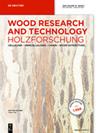The effect of the growth ring orientation on spring-back and set-recovery in surface-densified wood
IF 1.6
3区 农林科学
Q2 FORESTRY
引用次数: 2
Abstract
Abstract Wood under thermo-mechanical densification behaves differently depending on the cross-sectional growth ring orientation (GRO) relative to the direction of compression. This influences the degree of cell damage, but also the shape-memory effects occurring when the compression load is released (spring-back) and when the timber is re-moistened (set-recovery). To study how the GRO influences the shape-memory effects, Scots pine specimens were separated into three distinct groups of GRO (Flat, Inclined, Hybrid) and then thermo-mechanically surface-densified. Spring-back and set-recovery were determined by thickness measurements and by digital image correlation. A GRO parallel to the densified surface, resulted in a low spring-back and a high set-recovery which were uniform over the width of the specimen. Specimens with a GRO between 15 and 45° to the densified surface showed high spring-back and low set-recovery, indicating cell-wall damage. Spring-back mainly occurred in the non-plasticised region immediately below the heated surface region and elasto-plastic rolling-shear deformation along individual growth rings occurred. The GRO of softwood subjected to thermo-mechanical densification determines if an applied load results in rolling shear-deformation or radial compression. This in turn determines where in the cross-section and when in the process the cells deform and if this deformation occurs below or above the glass-transition temperature.生长环取向对表面致密木材回弹和凝固恢复的影响
摘要木材在热机械致密化下的表现不同,这取决于相对于压缩方向的横截面生长环取向(GRO)。这会影响细胞损伤的程度,但也会影响压缩载荷释放(回弹)和木材重新润湿(恢复原状)时产生的形状记忆效应。为了研究GRO如何影响形状记忆效应,将苏格兰松标本分为三组不同的GRO(扁平、倾斜、混合),然后进行热机械表面致密化。回弹和凝固恢复通过厚度测量和数字图像相关来确定。平行于致密表面的GRO导致较低的回弹和较高的凝固恢复,这在试样的宽度上是均匀的。GRO与致密表面之间为15°至45°的样品显示出高回弹性和低凝固恢复性,表明细胞壁损伤。回弹主要发生在加热表面区域正下方的非塑化区域,沿单个生长环发生弹塑性滚动剪切变形。经过热机械致密化处理的软木的GRO决定了施加的载荷是否会导致滚动剪切变形或径向压缩。这反过来决定了细胞在横截面中的何处以及在该过程中何时变形,以及这种变形是否发生在玻璃化转变温度以下或以上。
本文章由计算机程序翻译,如有差异,请以英文原文为准。
求助全文
约1分钟内获得全文
求助全文
来源期刊

Holzforschung
工程技术-材料科学:纸与木材
CiteScore
4.60
自引率
4.20%
发文量
83
审稿时长
3.3 months
期刊介绍:
Holzforschung is an international scholarly journal that publishes cutting-edge research on the biology, chemistry, physics and technology of wood and wood components. High quality papers about biotechnology and tree genetics are also welcome. Rated year after year as one of the top scientific journals in the category of Pulp and Paper (ISI Journal Citation Index), Holzforschung represents innovative, high quality basic and applied research. The German title reflects the journal''s origins in a long scientific tradition, but all articles are published in English to stimulate and promote cooperation between experts all over the world. Ahead-of-print publishing ensures fastest possible knowledge transfer.
 求助内容:
求助内容: 应助结果提醒方式:
应助结果提醒方式:


